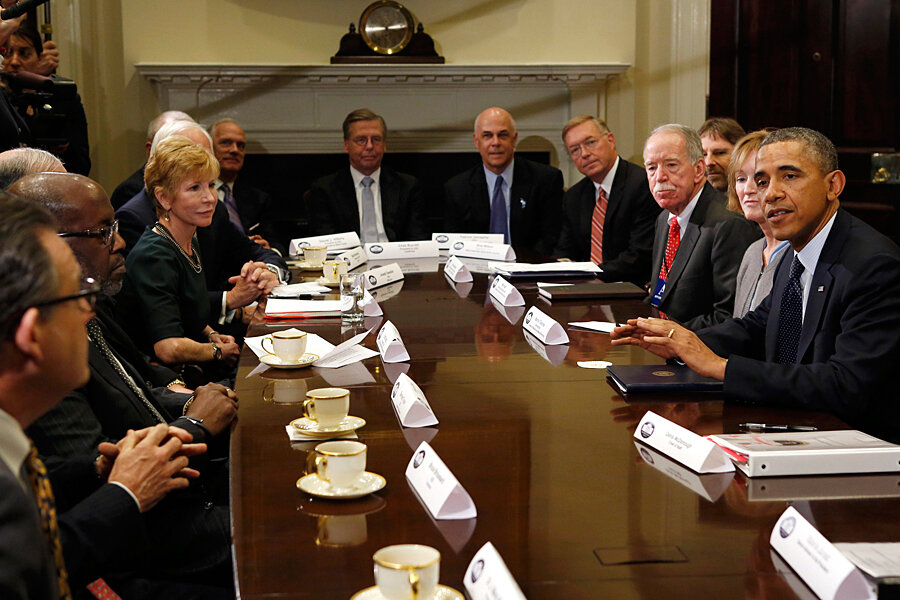House votes to reinstate insurance plans. Will such fixes sink Obamacare?
Loading...
| Washington
Washington is full of ideas on how to fix the fully loaded SUV known as Obamacare. On Thursday, President Obama offered his fix. On Friday, members of the House – including 39 Democrats – approved theirs, and other lawmakers have their own ideas. But all these busy mechanics could end up doing more damage to Obamacare.
How’s that?
Well, start with the general aim of the various repairs. They differ in detail, but basically, they would allow – for varying times – millions of Americans whose health insurance is being canceled under Obamacare to keep their plans and their doctors if they like them. Just like Mr. Obama originally promised.
So far, at least 4.2 million Americans have been sent cancellation notices by their insurers, according to an Associated Press survey. The important thing to remember about this group is that it tends to be healthier than the uninsured, who will be most attracted to Obamacare. If you allow these healthier individuals to remain outside the Obamacare pool, you are spelling actuarial trouble. It’s like removing a piston from an engine and still expecting it to run smoothly.
No one is sure exactly how big this problem could become, but the fear is that the Obamacare exchanges “will be attracting a disproportionate share of the higher-cost, sicker people,” says Cori Uccello, senior health fellow at the American Academy of Actuaries. That translates into higher premiums and, potentially, an insurance system that can’t adequately support itself.
From insurers’ point of view, it’s just too late to reverse course and implement the change. Some state insurance commissioners say that bringing back these canceled policies will actually violate new state laws that now forbid such “substandard” plans. Two biggies in this group are California and New York.
A reversal could just add to the confusion and lack of confidence already swirling around Obamacare. A crisis of confidence in the new health-care system could be debilitating. Take it from Larry Kocot, a visiting fellow at the Brookings Institution who helped roll out Medicare Part D, the prescription drug benefit, during the George W. Bush administration.
Back then, they called Part D’s stumbles “glitches,” but the rollout of Obamacare has “surpassed glitches,” he says. “It’s very, very hard to address confusion.”
So why make such repairs, when their downsides are so numerous? For one, the blowback from those unhappy with the cancellations has reached the force of a “Category 5 political hurricane,” as Rep. Greg Walden (R) of Oregon put it at a Monitor breakfast Friday. Real people, kicked off plans they liked, are now facing higher premiums and deductibles – and they’re telling their members of Congress about it.
Obama’s approval rating, too, has sunk to 39 percent. On Thursday, he tried to shield Democrats in Congress, some of whom face tough races in the midterm elections of 2014, by announcing an executive fix that leaves it up to insurers and states to allow people to return to their old health plans if they want to.
But the politics of Obamacare has become so damaging to Democratic lawmakers, who “own” Obamacare as much as the president does, that nearly 40 House Democrats peeled from their caucus to support Friday’s bill, backed by Rep. Fred Upton (R) of Michigan.
Most Democrats don’t like this bill, and Obama promises to veto it, because it allows new customers to sign on to canceled plans – enlarging the pool of people who could be attracted to the plans and worsening the outlook for Obamacare’s sustainability.
Instead, Democrats such as Sen. Mary Landrieu of Louisiana, who has been criticized at home for her support of Obamacare and who faces a tough race next year, are working on their own legislation.
Where all this is headed is tough to say. But the rollout is producing problems beyond a broken website. Fixing them is like pulling on a loose thread. Give it a tug, and things start to unravel.





